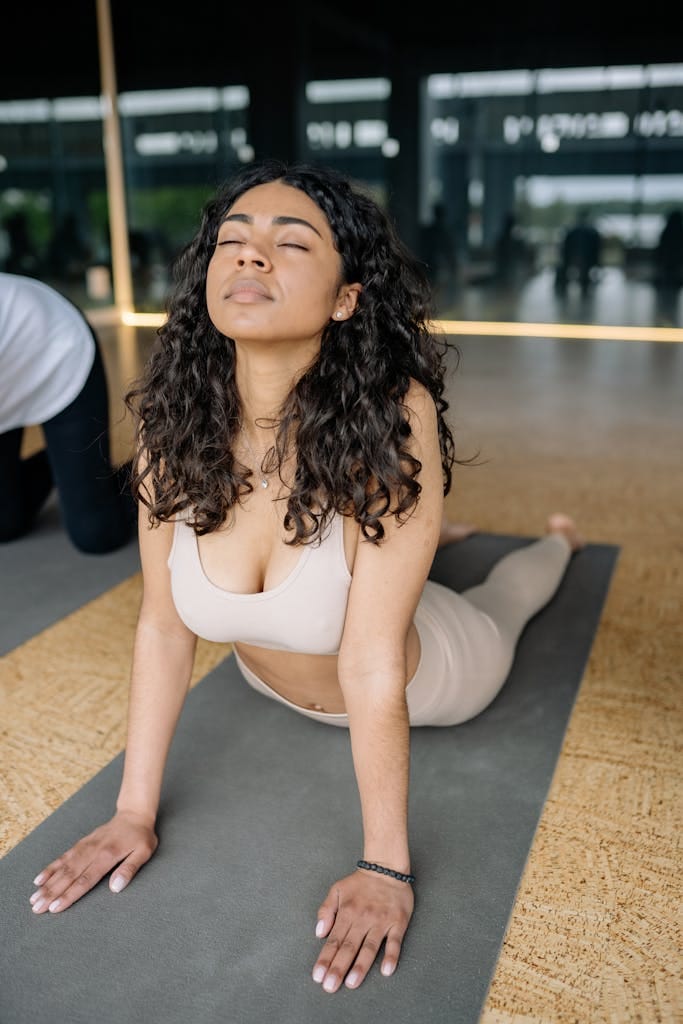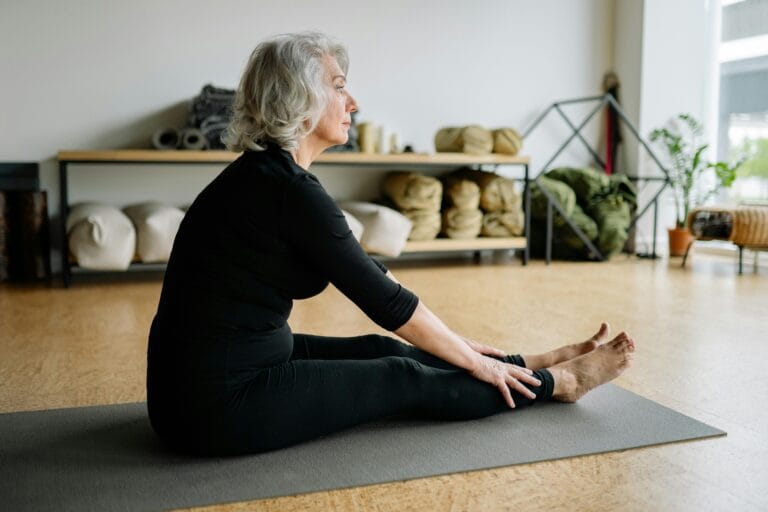FREE SHIPPING OVER $50
Can’t Sleep? These 5 Yoga Poses Work Like Natural Sedatives

It’s a frustratingly familiar scene: the lights are off, the room is quiet, but your mind is wide awake. You toss and turn, the hours tick by on the clock, and with each passing minute, your anxiety about not sleeping grows. For millions of people struggling with insomnia and poor sleep quality, the search for a solution can be endless. While medication and supplements offer a temporary fix, many are looking for a natural, sustainable way to calm their bodies and minds.
The good news is, a solution exists, and it’s simpler than you might think. A short, gentle yoga practice before bed can work like a powerful natural sedative, helping you wind down from the day and transition into deep sleep. These aren’t strenuous, sweat-inducing poses. Instead, they are quiet, restorative movements designed to release physical tension and calm the nervous system. You don’t need to be a yoga expert or even own a mat. You just need a quiet space, about 15 minutes, and a willingness to try something new.
The Science of Sleep: Why Yoga Works Like a Natural Sedative
To understand why these poses are so effective, you first have to understand what keeps you awake. When you are stressed, worried, or overstimulated, your body’s sympathetic nervous system goes into overdrive. This is your “fight or flight” response, which floods your body with stress hormones like cortisol, raises your heart rate, and makes it impossible to relax.
Gentle yoga and mindful breathing work in direct opposition to this. They activate your parasympathetic nervous system, often called the “rest and digest” system. This action sends a powerful signal to your body that it’s safe to relax.
Benefits of these Yoga Poses:
- Cortisol Levels Drop: The deep breathing and gentle stretching help to lower your body’s stress hormones, reducing the physiological anxiety that prevents sleep.
- Melatonin Production Increases: The relaxation response helps your body naturally produce melatonin, the hormone that regulates your sleep-wake cycle.
- Muscles Release Tension: The poses target areas where stress is often stored—the hips, back, and shoulders—releasing physical knots that can cause discomfort and restlessness.
These powerful, natural responses are why these five simple poses can be as effective as a sedative, preparing your body and mind for a night of profound, restorative sleep.
The 5 Yoga Poses That Work Like Natural Sedatives
The key to this routine is to move slowly and mindfully, linking each pose with deep, calming breaths. Try to hold each pose for 1-2 minutes, focusing on the sensation in your body and letting go of any thoughts that enter your mind.
1. Child’s Pose (Balasana)
This is the perfect pose to start your bedtime ritual, as it’s a deeply calming and grounding position that signals to your body that it’s time to rest. It gently stretches your lower back, hips, and thighs.
- How to do it: Begin on your hands and knees. Separate your knees a little wider than your hips while keeping your big toes touching. Slowly bring your hips back to rest on your heels. Lower your torso down between your thighs, resting your forehead on the floor or on a pillow. Extend your arms forward or rest them by your sides. Breathe deeply, feeling your belly press against your thighs.
- Why it works: The gentle forward fold and the pressure on your forehead from the floor can have an incredibly calming effect on your mind. It encourages deep, rhythmic breathing, which is the first step in activating the parasympathetic nervous system.
2. Supine Spinal Twist (Supta Matsyendrasana)
Twisting poses are excellent for releasing tension in the spine and the muscles of your back. This pose gently wrings out your spine, which helps to relieve tightness and promote a feeling of release.
- How to do it: Lie on your back with your arms stretched out to your sides at shoulder height, palms facing up. Bend both knees and draw them into your chest. Slowly let both knees fall to the right side, keeping your shoulders firmly on the floor. Turn your head to look to the left. Hold this position, focusing on the gentle stretch. Bring your knees back to center, then let them fall to the left side, turning your head to the right.
- Why it works: The spinal twist helps to gently release knots and tension in the back, a common area for stress to accumulate. The focus on your breath and the simple, repetitive movement can be very meditative.
3. Legs-Up-the-Wall (Viparita Karani)
This is one of the most effective and restorative poses in all of yoga. It’s fantastic for both the mind and the body, providing a sense of weightlessness and deep relaxation.
- How to do it: Sit with one hip as close to the wall as possible. Slowly swing your legs up the wall as you lower your back to the floor. Your body should be in an “L” shape, with your legs straight up the wall and your back flat on the floor. Place a pillow under your head for comfort if needed. Rest your arms comfortably at your sides, with your palms facing up.
- Why it works: Inverting your body and elevating your legs can improve circulation, helping to drain fluid from your feet and ankles. It also calms the nervous system and can reduce feelings of anxiety and restlessness.
4. Reclined Bound Angle Pose (Supta Baddha Konasana)
This pose is a wonderful hip opener that releases tension from your hips and inner thighs. The hips are often referred to as an emotional “storage closet,” so releasing tension here can have a profound effect on your mental state.
- How to do it: Lie on your back, bend your knees, and bring the soles of your feet together. Let your knees fall open to the sides. You can place pillows or rolled-up blankets under your knees for support if the stretch feels too intense. Place one hand on your heart and the other on your belly and simply focus on your breath.
- Why it works: This position encourages deep, open-chest breathing and gently stretches the groin and hips, which can hold a significant amount of stress and tension. This pose provides a deep sense of release and is incredibly soothing.
5. Corpse Pose (Savasana)
This is the final, and arguably most important, pose of any yoga practice. It’s where you fully surrender and allow your body to absorb all the benefits of the movements you just performed.
- How to do it: Lie flat on your back with your arms resting by your sides, palms facing up. Let your feet fall open naturally. Close your eyes and simply breathe. Consciously relax every part of your body, from the tips of your toes to the crown of your head. Allow your thoughts to come and go without judgment.
- Why it works: This pose teaches you to let go and be completely present. It is a meditative state that allows your mind and body to fully disconnect from the stresses of the day, preparing you for the tranquil state of sleep.
Creating Your Bedtime Ritual: More Than Just the Poses
The true power of this routine lies in its consistency and the ritual you build around it. By performing these poses every night, you are training your body to associate this sequence with relaxation and sleep.
- Set the Mood: About 30 minutes before your planned bedtime, turn off all screens and dim the lights. Put on a calming playlist or simply enjoy the silence. Put on comfortable pajamas and make a point of winding down.
- Breathe with Intention: As you move through the poses, focus on your breath. Inhale deeply through your nose for a count of four, and exhale slowly through your mouth for a count of six. This simple technique is scientifically proven to lower your heart rate and calm your nervous system.
- Make it a Habit: Start small, even if you can only do the routine for 5 minutes. The most important thing is showing up for yourself every night. Over time, your body will start to crave this nightly ritual, and you’ll find that sleep comes much more naturally.
Beyond the Mat: Lifestyle Habits for Deep Sleep
While this yoga routine is incredibly effective, it works best when paired with a few other healthy lifestyle habits.
- Watch What You Eat: Avoid heavy meals, caffeine, and alcohol close to bedtime. These can disrupt your sleep cycles and make it difficult to achieve deep sleep.
- A Consistent Schedule: Your body loves routine. Go to bed and wake up at roughly the same time every day, even on weekends, to regulate your internal clock.
- Optimal Sleep Environment: Ensure your bedroom is cool, dark, and quiet. Your body’s temperature naturally drops as you sleep, and a cool room supports this process.
Reclaiming Your Sleep, One Pose at a Time
The frustration of insomnia and sleepless nights is a very real problem. But the solution doesn’t have to be complex or chemical. These five simple yoga poses are a powerful tool to calm your nervous system, release physical tension, and signal to your body that it’s time to rest.
By dedicating just a few minutes each night to this gentle, natural routine, you can train your body to relax on command. You can move from a state of constant stress to one of calm and tranquility, finally allowing yourself the deep sleep you’ve been craving. The power to sleep like a baby is within your reach, just a few poses away.
Related Articles
- Experts Say This 4-Minute Chair Yoga Routine Erases Neck Pain and Desk Strain—No Experience Needed
- 10 Effortless Yoga Poses That Help Plus-Size Seniors Build Strength & Confidence—No Flexibility Needed
- 75 and FIERCE: Her Yoga Secret That SHAVED Decades Off Her Body in 30 Days! (See the Shocking Before & After)
- Weak Balance? This 7-Minute Routine Strengthens Stability Better Than Yoga (No Mat Required)
- The 3 Seated Yoga Poses You Should Be Doing Right Now for Better Flexibility







